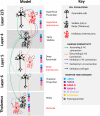Modulation of long-term potentiation following microdoses of LSD captured by thalamo-cortical modelling in a randomised, controlled trial
- PMID: 38317077
- PMCID: PMC10845757
- DOI: 10.1186/s12868-024-00844-5
Modulation of long-term potentiation following microdoses of LSD captured by thalamo-cortical modelling in a randomised, controlled trial
Abstract
Background: Microdosing psychedelics is a phenomenon with claimed cognitive benefits that are relatively untested clinically. Pre-clinically, psychedelics have demonstrated enhancing effects on neuroplasticity, which cannot be measured directly in humans, but may be indexed by non-invasive electroencephalography (EEG) paradigms. This study used a visual long-term potentiation (LTP) EEG paradigm to test the effects of microdosed lysergic acid diethylamide (LSD) on neural plasticity, both acutely while on the drug and cumulatively after microdosing every third day for six weeks. Healthy adult males (n = 80) completed the visual LTP paradigm at baseline, 2.5 h following a dose of 10 µg of LSD or inactive placebo, and 6 weeks later after taking 14 repeated microdoses. Visually induced LTP was used as indirect index of neural plasticity. Surface level event-related potential (ERPs) based analyses are presented alongside dynamic causal modelling of the source localised data using a generative thalamocortical model (TCM) of visual cortex to elucidate underlying synaptic circuitry.
Results: Event-related potential (ERP) analyses of N1b and P2 components did not show evidence of changes in visually induced LTP by LSD either acutely or after 6 weeks of regular dosing. However modelling the complete timecourse of the ERP with the TCM demonstrated changes in laminar connectivity in primary visual cortex. This primarily included changes to self-gain and inhibitory input parameters acutely. Layer 2/3 to layer 5 excitatory connectivity was also different between LSD and placebo groups. After regular dosing only excitatory input from layer 2/3 into layer 5 and inhibitory input into layer 4 were different between groups.
Conclusions: Without modulation of the ERPs it is difficult to relate the findings to other studies visually inducing LTP. It also indicates the classic peak analysis may not be sensitive enough to demonstrate evidence for changes in LTP plasticity in humans at such low doses. The TCM provides a more sensitive approach to assessing changes to plasticity as differences in plasticity mediated laminar connectivity were found between the LSD and placebo groups.
Trial registration: ANZCTR registration number ACTRN12621000436875; Registered 16/04/2021 https://www.anzctr.org.au/Trial/Registration/TrialReview.aspx?id=381476 .
Keywords: Dynamic causal modelling; Long-term potentiation; Lysergic acid diethylamide; Neuroplasticity; Psychedelics.
© 2024. The Author(s).
Conflict of interest statement
SM, and RLS have received research funding from MindBio Therapeutics Ltd. to conduct further work in psychedelic microdosing. SM has received funding from atai Life Sciences for unrelated research work. No other authors report biomedical financial interests or conflicts of interest.
Figures






Similar articles
-
Prescription of Controlled Substances: Benefits and Risks.2025 Jul 6. In: StatPearls [Internet]. Treasure Island (FL): StatPearls Publishing; 2025 Jan–. 2025 Jul 6. In: StatPearls [Internet]. Treasure Island (FL): StatPearls Publishing; 2025 Jan–. PMID: 30726003 Free Books & Documents.
-
Psychedelic-assisted therapy for treating anxiety, depression, and existential distress in people with life-threatening diseases.Cochrane Database Syst Rev. 2024 Sep 12;9(9):CD015383. doi: 10.1002/14651858.CD015383.pub2. Cochrane Database Syst Rev. 2024. PMID: 39260823
-
The Black Book of Psychotropic Dosing and Monitoring.Psychopharmacol Bull. 2024 Jul 8;54(3):8-59. Psychopharmacol Bull. 2024. PMID: 38993656 Free PMC article. Review.
-
Systemic pharmacological treatments for chronic plaque psoriasis: a network meta-analysis.Cochrane Database Syst Rev. 2021 Apr 19;4(4):CD011535. doi: 10.1002/14651858.CD011535.pub4. Cochrane Database Syst Rev. 2021. Update in: Cochrane Database Syst Rev. 2022 May 23;5:CD011535. doi: 10.1002/14651858.CD011535.pub5. PMID: 33871055 Free PMC article. Updated.
-
Systemic pharmacological treatments for chronic plaque psoriasis: a network meta-analysis.Cochrane Database Syst Rev. 2020 Jan 9;1(1):CD011535. doi: 10.1002/14651858.CD011535.pub3. Cochrane Database Syst Rev. 2020. Update in: Cochrane Database Syst Rev. 2021 Apr 19;4:CD011535. doi: 10.1002/14651858.CD011535.pub4. PMID: 31917873 Free PMC article. Updated.
Cited by
-
Psychedelic-Induced Neural Plasticity: A Comprehensive Review and a Discussion of Clinical Implications.Brain Sci. 2025 Jan 25;15(2):117. doi: 10.3390/brainsci15020117. Brain Sci. 2025. PMID: 40002450 Free PMC article. Review.
-
Psilocybin-assisted neurofeedback for the improvement of executive functions: a randomized semi-naturalistic-lab feasibility study.Philos Trans R Soc Lond B Biol Sci. 2024 Dec 2;379(1915):20230095. doi: 10.1098/rstb.2023.0095. Epub 2024 Oct 21. Philos Trans R Soc Lond B Biol Sci. 2024. PMID: 39428872 Clinical Trial.
-
Is microdosing a placebo? A rapid review of low-dose LSD and psilocybin research.J Psychopharmacol. 2024 Aug;38(8):701-711. doi: 10.1177/02698811241254831. Epub 2024 Jun 14. J Psychopharmacol. 2024. PMID: 38877715 Free PMC article. Review.
-
Effects of psychoplastogens on blood levels of brain-derived neurotrophic factor (BDNF) in humans: a systematic review and meta-analysis.Mol Psychiatry. 2025 Feb;30(2):763-776. doi: 10.1038/s41380-024-02830-z. Epub 2024 Nov 29. Mol Psychiatry. 2025. PMID: 39613915 Free PMC article.
-
Multimodal creativity assessments following acute and sustained microdosing of lysergic acid diethylamide.Psychopharmacology (Berl). 2025 Feb;242(2):337-351. doi: 10.1007/s00213-024-06680-z. Epub 2024 Sep 5. Psychopharmacology (Berl). 2025. PMID: 39235512 Free PMC article. Clinical Trial.
References
Publication types
MeSH terms
Substances
Associated data
Grants and funding
LinkOut - more resources
Full Text Sources

